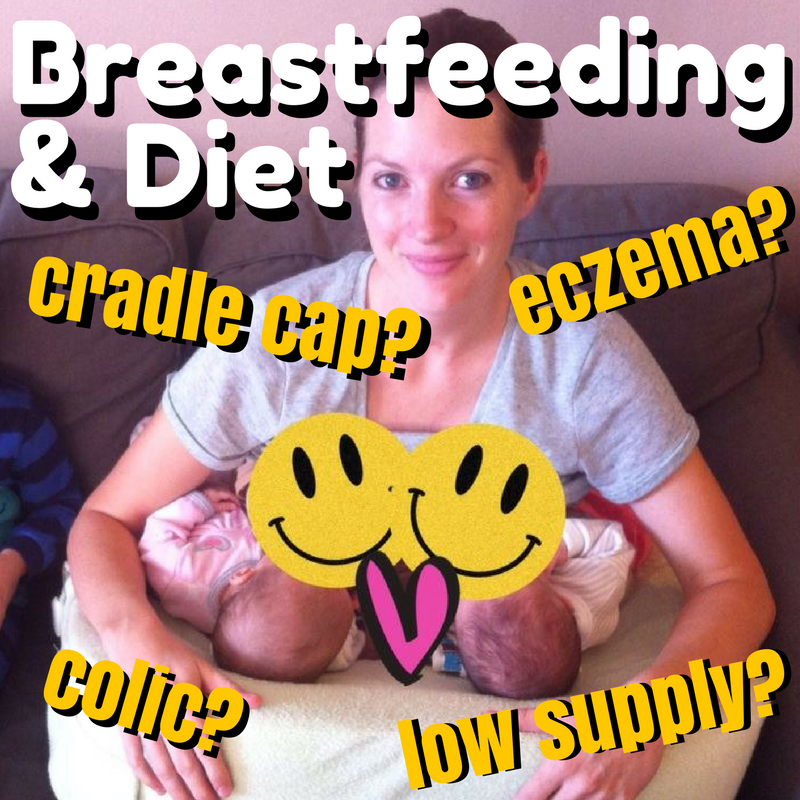|
Originally posted onMommy Nearest
Most of us are very aware that what we consume while pregnant will pass through to our baby in the womb—that's why we do our best to eat well-balanced meals, take vitamins and stay healthy. But did you know that what you consume while breastfeeding could be causing problems for your baby (and thus yourself)!? I chatted with food and wellness educator Ebeth Johnson, aka The Breastfeeding Chef, to talk about breastfeeding nutrition and its effects on mother and baby. She experienced first hand how changing your diet while breastfeeding can eliminate things such as colic, cradle cap and eczema.
Not having enough milk is a huge concern for expecting and new moms. Are there certain foods that will help maintain or build the quantity of milk produced?
The best way to increase your supply is to put your baby on your breast as much as possible, pump after feedings, and make sure you’re drinking plenty of water—you’re hydrating yourself and the baby. Beyond that, there are various lactogenic foods that will increase the milk supply of breastfeeding mothers, however they effect each woman to a different extent. Most women can see the impact of lactogenic foods within 4 to 7 days of consistent use, though some will experience changes within 48 hours. Foods that will help your supply include green leafy vegetables (especially kale, collards and mustard greens), oats, barley, carrots, hemp seeds, sesame seeds, flax seeds, quinoa, figs, sea vegetables, nutritional yeast, fennel, almonds, macadamia, cashew, walnut, ginger, and garlic. Just be careful—using a few lactogenic foods over and over will cause them to lose their effectiveness. Instead, eat a variety of lactogenic foods over time.
On the flip side, are there any foods that could decrease milk production that breastfeeding moms should avoid?
Actually, yes, there are many anti-lactogenic foods that can decrease a breastfeeding mother’s milk supply. Such herbs and foods include peppermint, sage, parsley, rosemary, thyme, coffee, black tea, green tea, chocolate, soft drinks and carbonated beverages, citric acid, vitamin c supplements, tomatoes, paprika, and citrus fruits. Some women may consume a small amount of anti-lactogenic foods and experience major effects while others may eat large quantities and experience no effect at all. My suggestion is that you avoid these foods for the first three to four weeks after birth.
Colic is common, but a pretty horrific thing for new parents to deal with. When you have a colicky baby who screams all evening, you’re often told there is no cause or cure and you just have to wait it out, for months. What’s your take?
My own research revealed that colic may be caused by contractions of immature intestines as they try to digest food or by gas trapped in the intestines. Since it seems the issue resides in the digestive system, this suggests that the maternal diet may have something to do with its cause and can perhaps have the ability to relieve or soothe its painful effects. If you have a baby with colic, the first thing I suggest is to remove all dairy products from your diet—dairy is the number one dietary cause of colic and may take up to 14 days to completely leave your milk and stop causing challenges for your newborn. You might also consider decreasing consumption of or eliminating other common triggers including wheat, refined sugar and flours, gluten, chocolate, peanuts, cabbage, cauliflower, broccoli, onions, garlic, and even too much fruit (especially peaches, plums, grapes, strawberries and pineapple). At the same time, consume caffeine-free teas that contain catnip, dill, fennel, lemon balm and cinnamon (these can help relieve the painful cramping of colic as well as ease digestion for both you and your baby) and consume foods high in magnesium. Colicky babies secrete more magnesium in their urine due to their high level of stress. This magnesium needs to be replaced because magnesium deficiency leads to muscle spasms, like those experienced in the gut of colicky babies. Above all, hold your baby more—colic is linked to emotional upset that can be soothed somewhat by skin to skin contact and nursing on demand.
How about eczema? Is that food-related as well?
It can be. Infants with eczema most often get it as a response to formula or something their mother ate that came through breast milk. The most common food triggers of eczema are dairy, wheat, corn, soy, citrus, wheat, eggs and bananas. You’ll want to consider eliminating those as well as increasing your intake of omega 3 and omega 6 fatty acids and zinc. Some zinc rich power foods are ground raw sesame seeds, raw pumpkin seeds, adzuki beans, raw sunflower seeds, wild rice, edamame, shitake mushrooms, tahini and kale. In the meantime, massage your baby twice-daily with one tablespoon flax seed oil, one capsule of borage (220mg) or primrose oil (500mg).
Let’s talk cradle cap. It doesn’t seem to bother the babies, but it’s pretty tough to see your little one’s scalp covered in this gunk. Do you really think it’s the result of what the baby (and mother) is ingesting?
Yes! Cradle cap is often associated with an intolerance to formula or a food in the maternal diet. One of the most common dietary causes of cradle cap is milk and dairy products, however eggs, wheat, nuts, peanuts, shellfish, soy and corn are also usual suspects. My suggestion is to remove all dairy and eggs from your diet, increase your consumption of magnesium, zinc, biotin and essential fatty acids (hemp seeds, flax seeds, walnuts, and cod liver oil), and treat the cradle cap topically (massage with oil, leave on overnight, and rinse and gently rub with a warm wet washcloth in the morning). If cradle cap persists, try eliminating another possible dietary cause listed above.
What foods should be increased or avoided for reflux?
Add foods that are soothing to the digestive tract, including ginger, aloe vera, melon, fennel, asparagus, green beans, leafy greens, root vegetables, brown rice, pseudo grains, and fresh papaya with the seeds. Make sure you’re getting enough calcium, magnesium, potassium and B12. Avoid trigger foods like chocolate, mint, citrus, raw onion, caffeine, carbonated beverages, alcohol, dairy, and fried and grilled foods.
Have you treated any of your baby’s ailments through an elimination diet? If so, let us know how it went below.
61 Comments
8/31/2017 11:50:33 am
There is no doubt about it, a solid daily weight loss diet plan will help guide you to your weight loss goals. Especially if you're a beginning dieter, the best diet plans will walk you through the first stages and almost guaranteed you a quicker route to success. One of the best daily weight loss diet plan is Weight Watchers.
Reply
3/29/2020 09:13:43 pm
I was reading through some of your posts on this site and I believe this website is really informative! Continue posting.
Reply
3/30/2020 12:36:30 am
I was reading through some of your posts on this site and I believe this website is really informative! Continue posting.
Reply
7/16/2020 05:58:55 am
Greetings to each one, it's really a particular for me to visit this website page, it comprises of helpful Information.
Reply
5/14/2021 11:19:20 am
Excellent article. I certainly love this site. Keep writing! <a href="https://qurist.in">Pure CBD Oil In India</a>
Reply
5/18/2021 11:00:42 am
I wanted to thank you for this very good read!! I absolutely loved every little bit of it. I have got you saved as a favorite to look at new things you postO <a href="https://qurist.in">Buy CBD Oil In India</a>
Reply
6/15/2021 08:44:05 am
I really thank you for the gainful data on this wonderful subject and foresee more inconceivable posts. Thankful for getting a charge out of this greatness article with me. I am esteeming everything that much! Envisioning another great article. Favorable circumstances to the maker! All the best!
Reply
7/3/2021 07:09:42 am
Thanks for sharing your info. I really appreciate your efforts and I am waiting for your next write ups thank you once again.
Reply
7/3/2021 07:35:02 am
Thanks for sharing info about it. Really a great addition. I have actually reviewed this wonderful post. I actually like that. Thanks so lot for your post.
Reply
7/14/2021 02:28:38 am
Incredible Info! I Recently Came Across Your Blog And Have Been Reading Along. I Thought I Would Leave My First Comment. I Don't Know What To Say Except That I Have.
Reply
7/18/2021 05:27:52 am
Excellent post. I will be experiencing a few of these issues as well.
Reply
8/3/2021 12:21:12 pm
Great post I like it very much keep up the good work..<a href="https://shuddhideaddictioncentre.com/city-pages/nasha-mukti-kendra-raipur/3222-62.html">Nasha Mukti Kendra in Raipur</a>
Reply
8/3/2021 12:27:03 pm
I think this post will be a fine read for my blog readers too, could you please allow me to post a link to my blog. I am sure my guests will find that very useful. <a href="https://shuddhideaddictioncentre.com/city-pages/nasha-mukti-kendra-raipur/3222-62.html">Nasha Mukti Kendra in Raipur</a>
Reply
8/4/2021 01:49:19 am
Cool you write, the information is very good and interesting,
Reply
8/31/2021 10:19:02 am
Great post, very informative. I wonder why the other experts of this sector do not realize this. You should continue your writing. I am sure, you have a huge readers’ base already! .
Reply
8/31/2021 11:04:33 am
I would like to say that this blog really convinced me to do it! Thanks, very good post
Reply
9/13/2021 04:40:03 am
I’m not that much of an internet reader to be honest but your blogs really nice, keep it up! I’ll go ahead and bookmark your website to come back down the road.
Reply
11/25/2021 04:48:03 am
I love what you all are up as well. This kind of smart work and inclusion! Keep up the incredible works folks I've included you all to our blogroll.
Reply
11/25/2021 06:16:17 am
Very elegantly composed. This blog has every one of the necessary parts that I was searching for. The focuses are all around featured, expressing the genuine importance. Straightforward and read.
Reply
2/15/2022 07:33:37 am
This is a good post without any doubts. You really doing a great job. I really inspired from you.
Reply
2/16/2022 04:37:31 am
The article is very interesting and effective. Thank you and good luck in the upcoming articles.
Reply
4/17/2022 05:35:09 am
I was interested assuming that you whenever envisioned of adjusting the design of your site? Its well created I truly like what youve got to say. Yet, most likely you could a little more in the method of material so people could get together with it better.
Reply
5/31/2022 03:21:04 am
It is a completely interesting blog publish.I often visit your posts for my project's help about Diwali Bumper Lottery and your super writing capabilities genuinely go away me taken aback.Thank you a lot for this publish.
Reply
10/2/2022 08:30:18 am
كما تقدم الشركة الهندسية مجموعة من افضل <a href=""https://eieca-eg.com/plastic-processing-machinery//> ماكينات تصنيع البلاستيك </a> في الوطن العربي حيث تقدم ماكينات عالية الجودة بكفائة عالية.
Reply
10/17/2022 06:18:23 am
I was intrigued accepting that you at whatever point imagined of changing the plan of your site? Its very much made I genuinely like what you've got to say. However, no doubt you might somewhat more in the technique for material at some point so individuals could get along with it better.
Reply
11/25/2022 02:00:42 am
Dynamite work! This is the kind of data that ought to be shared around the net. Disgrace on the web indexes for not situating this post higher! Come on finished and visit my site.
Reply
4/16/2023 02:58:59 am
Your blog is very good. I wish to see much more like this. Thanks for sharing your information.
Reply
4/29/2023 05:33:34 am
I like your blog very much keep doing this kind of writing.
Reply
7/6/2023 02:47:19 am
The article sheds light on an important topic: how a breastfeeding mom's diet can impact her baby. It highlights the significance of maintaining a balanced and nutritious diet to provide essential nutrients to the baby through breast milk. Understanding these connections can help moms make informed choices about their own diet, ensuring optimal health and development for their little ones.
Reply
8/23/2023 08:43:59 am
Very nice article and it has lots of information and proper way of explaining the content.
Reply
8/28/2023 11:42:56 am
You've managed to explain a complex topic in an understandable way. Well done!
Reply
9/29/2023 05:24:25 am
You made some good points there. I did a search on this topic and found that most people will agree with your blog.
Reply
10/23/2023 01:45:12 am
I've shared this post with my friends because I think it's something everyone should read.
Reply
10/30/2023 03:26:13 am
You made some good points there. I did a search on this topic and found that most people will agree with your blog.
Reply
11/3/2023 05:10:37 am
Great site you have here. Nowadays it is difficult to find quality texts like yours. I really appreciate people like you! Take care!
Reply
11/4/2023 04:47:31 am
I had never thought about this from that perspective before. Thanks for opening my eyes to this issue.
Reply
11/6/2023 03:47:44 am
You've definitely given a brand new twist to a topic that's been debated for a long time.
Reply
11/16/2023 02:11:38 am
I really love your site. Excellent colours, subject and writing. Thank you for sharing.
Reply
12/3/2023 04:42:59 am
Your blog is a treasure trove of information. I always find something new and valuable with each visit.
Reply
12/4/2023 01:42:33 am
Your blog is a treasure trove of information. I always find something new and valuable with each visit.
Reply
12/6/2023 01:29:38 am
Your blog is a treasure trove of information. I always find something new and valuable with each visit.
Reply
12/21/2023 06:57:52 am
I went over this website and I believe you have a lot of wonderful information,
Reply
12/29/2023 06:35:30 am
The way you connect with your audience is truly remarkable. Your blog feels like a conversation with a knowledgeable friend.
Reply
1/31/2024 08:17:38 am
Your writing is always informative and engaging. I learn something new every time I read one of your articles.
Reply
4/17/2024 03:02:07 am
Awesome article on blog commenting, keep up the good work Thank you. <a href="https://www.topindiandetectiveagency.com/private-detective-agency/kolkata.php "><strong> Detective Agency in Kolkata </strong></a>
Reply
That is the excellent mindset, nonetheless is just not help to make every sence whatsoever preaching about that mather. Virtually any method many thanks in addition to i had endeavor to promote your own article in to delicius nevertheless it is apparently a dilemma using your information sites can you please recheck the idea. thanks once more
Reply
7/6/2024 07:41:38 am
"Fantastic website! There's a wealth of useful information here. I've shared it with several friends and also posted it on Delicious. <a href="https://medi9.net/contact-us/">medi 9 kukatpally</a> Thank you for your hard work!"
Reply
Leave a Reply. |
About ME:I'm a NYC metro area mom blogger living in NJ with my Japanese husband & our 3 kids (twins plus 1), focusing on fun and honest product and travel reviews, saving moms time finding the best for their families! Find what you need in the menu bar or search section above! Categories
All
Archives
July 2024
|












 RSS Feed
RSS Feed



